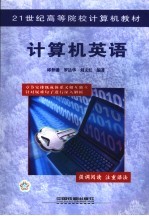图书介绍
计算机英语【2025|PDF下载-Epub版本|mobi电子书|kindle百度云盘下载】

- 邱仲潘,罗达华,刘文红编著 著
- 出版社: 北京:中国铁道出版社
- ISBN:7113071260
- 出版时间:2006
- 标注页数:347页
- 文件大小:37MB
- 文件页数:360页
- 主题词:电子计算机-英语-高等学校-教材
PDF下载
下载说明
计算机英语PDF格式电子书版下载
下载的文件为RAR压缩包。需要使用解压软件进行解压得到PDF格式图书。建议使用BT下载工具Free Download Manager进行下载,简称FDM(免费,没有广告,支持多平台)。本站资源全部打包为BT种子。所以需要使用专业的BT下载软件进行下载。如BitComet qBittorrent uTorrent等BT下载工具。迅雷目前由于本站不是热门资源。不推荐使用!后期资源热门了。安装了迅雷也可以迅雷进行下载!
(文件页数 要大于 标注页数,上中下等多册电子书除外)
注意:本站所有压缩包均有解压码: 点击下载压缩包解压工具
图书目录
CHAPTER 1 BASIC CONCEPT1
1.1 Storage1
1.1.1 Hard Disks1
1.1.2 Floppy Disks1
1.1.3 How Hard and Floppy Disks Work1
1.1.4 Compact Disks2
1.1.5 Uses of Floppy Disks2
1.1.6 Uses of Compact Disks2
1.2 Outer Hardware3
1.2.1 The Basics3
1.2.2 Input Devices3
1.2.3 Output Devices4
Notes4
Keywords5
Exercise5
Related Topics6
Additional Reading Flash Memory8
CHAPTER 2 HOW HARD DISKS WORK12
2.1 Hard Disk Basics12
2.2 Cassette Tape vs.Hard Disk12
2.3 Capacity and Performance13
2.4 Inside:Electronics Board13
2.5 Inside:Beneath the Board14
2.6 Inside:Platters and Heads14
2.7 Storing the Data14
Notes15
Keywords15
Exercise16
Related Topics16
Additional Reading How Tape Recorders Work20
3.1 The Basics24
3.2 Display Technology Background24
CHAPTER 3 HOW COMPUTER MONITORS WORK24
3.3 Display Technology:VGA25
3.4 Display Technology:DVI25
3.5 Viewable Area26
3.6 Maximum Resolution and Dot Pitch26
3.7 Refresh Rate26
3.8 Color Depth27
3.9 Power Consumption27
3.10 Monitor Trends:Flat Panels28
Notes28
Keywords29
Exercise30
Related Topics30
Additional Reading Liquid crystal display34
CHAPTER 4 COMPUTER MICE38
4.1 Evolution38
4.2 The Optical Mouse39
Notes40
Keywords41
Exercise41
Related Topics42
Additional Reading Floppy Disk Drives44
CHAPTER 5 HOW BITS AND BYTES WORK47
5.1 Decimal Numbers47
5.2 Bits47
5.3 Bytes48
5.4 Bytes:ASCII49
5.5 Standard ASCII Character Set50
5.6 Lots of Bytes51
5.7 Binary Math51
5.8 Quick Recap52
Notes52
Keywords52
Related Topics53
Exercise53
Additional Reading How Boolean Logic Works55
CHAPTER 6 MICROPROCESSORS63
6.1 Microprocessor History63
6.2 Microprocessor Progression63
6.3 Inside a Microprocessor64
6.4 Microprocessor Instructions66
6.5 Decoding Microprocessor Instructions69
6.6 Microprocessor Performance69
6.7 Microprocessor Trends70
6.8 64-bit Processors70
Notes71
Keywords71
Exercise72
Related Topics72
Additional Reading E-Commerce74
CHAPTER 7 APPLICATION SOFTWARE82
7.1 What is Software82
7.2 Programming Languages82
7.2.1 Assemblers82
7.2.2 Compilers and interpreters83
7.2.3 Nonprocedural Languages83
7.3 Libraries84
7.4 The Program Development Process84
7.4.1 Problem Definition84
7.4.2 Planning85
7.4.3 Writing the Program85
7.4.4 Debug and Documentation85
7.4.5 Maintenance85
7.5 Writing your Own Programs86
Notes86
Exercise87
Related Topics87
Keywords87
Additional Reading Computer software89
CHAPTER 8 COMPILER92
8.1 Introduction to Compiler92
8.2 Introduction and history92
8.3 Types of compilers93
8.4 Compiled vs interpreted languages93
8.5 Compiler design94
8.6 Compiler front end94
8.7 Compiler back end95
8.8 Notes95
8.9 References95
Notes96
Keywords96
Exercise96
Related Topics97
Additional Reading Assembly language99
9.1 A Little Terminology104
CHAPTER 9 HOW JAVA WORKS104
9.2 Downloading the Java Compiler105
9.3 Your First Program106
9.4 Understanding What Just Happened108
Notes110
Exercise111
Related Topics111
Keywords111
Additional Reading How Perl Works112
CHAPTER 10 POSITIONING VISUAL C++ IN THE DESKTOP DATABASE MARKET118
Notes120
Keywords121
Exercise121
Related Topics122
Additional Reading C++124
11.2.1 Strong artificial intelligence130
11.2 Strong AI and weak AI130
CHAPTER 11 ARTIFICIAL INTELLIGENCE130
11.1 Overview130
11.2.2 Weak artificial intelligence131
11.2.3 Philosophical criticism and support of strong AI131
11.3 History Development of AI theory132
Notes134
Keywords135
Exercise135
Related Topics136
Additional Reading Alan Turing138
CHAPTER 12 NEURAL NETWORK143
12.1 Structure143
12.1.1 Models143
12.3.1 Usefulness144
12.3 Applications144
12.2 Advantages144
12.1.2 Calculations144
12.3.2 Real life applications145
12.4 Types of neural networks145
12.4.1 Single-layer perceptron145
12.4.2 Multi-layer perceptron146
12.4.3 Recurrent network147
12.4.4 Hopfield network147
12.4.5 Boltzmann machine147
12.4.6 Committee of machines148
12.4.7 Instantaneously trained networks148
12.4.8 Spiking neural networks148
12.5 Relation to optimization techniques148
Notes149
Related Topics149
Keywords152
Additional Reading Genetic Algorithm153
Exercise153
CHAPTER 13 HOW DSL WORK160
13.1 Telephone Lines160
13.2 Asymmetrical DSL161
13.3 Distance Limitations161
13.4 Splitting the Signal:CAP162
13.5 Splitting the Signal:DMT162
13.6 DSL Equipment162
13.7 DSL Equipment:Transceiver163
13.8 DSL Equipment:DSLAM163
Notes163
Keywords164
Exercise164
Related Topics165
Additional Reading How Telephones Work167
14.1 A Network Example171
CHAPTER 14 INTERNET INFRASTRUCTURE171
14.2 Bridging The Divide172
14.3 Backbones172
14.4 Internet Protocol:IP Addresses Domain Name System172
14.5 Uniform Resource Locators173
14.6 Clients,Servers and Ports174
Notes175
Keywords175
Related Topics176
Exercise176
Additional Reading Modem178
DNS179
Uniform Resource Locator179
Client-server180
CHAPTER 15 HOW INTERNET SEARCH ENGINES WORK181
15.1 Looking at the Web181
15.1.1 An Itsy-Bitsy Beginning182
15.2 Building the Index183
15.1.2 Meta Tags183
15.3 Building a Search184
15.4 Future Search185
Notes185
Keywords186
Exercise187
Related Topics187
Additional Reading Internet Explorer190
CHAPTER 16 ENCRYPTION195
16.1 In the Key of195
16.1.1 Symmetric Key195
16.1.2 Public Key196
16.2 Hash This197
16.3 Are You Authentic197
Keywords199
Exercise199
Notes199
Related Topics200
Additional Reading Identity Theft202
CHAPTER 17 TAKING A CLOSER LOOK AT THE DCE211
17.1 Common threads211
17.2 Remote calls212
17.3 Directory services212
17.5 Distributed File System213
17.4 Distributed Security Service213
17.6 Distributed time service214
17.7 Extending and using the DCE214
Notes214
Keywords215
Exercise215
Related Topics215
Additional Reading How to Kerberize your site217
18.2 The MP3 Format227
CHAPTER 18 HOW MP3 FILES WORK227
18.1 introduction to MP3 files227
18.3 Using the MP3 Format228
18.4 Downloading and Listening229
18.5 Creating Your Own230
18.6 Distributing Original Music231
Notes231
Keywords231
Exercise232
Related Topics232
Additional Reading Sound Cards233
USB Ports236
CHAPTER 19 SHOCKWAVE 3-D TECHNOLOGY241
19.1 Uses of Shockwave Technology242
19.2 Making 3-D Content Accessible243
Notes245
19.3 Developing New 3-D Content245
Keywords246
Exercise246
Related Topics247
Additional Reading Computer Viruses252
CHAPTER 20 HOW PLAYSTATION 2 WORKS259
20.1 History259
20.2 Console260
20.3 Controller262
20.4 Games264
Notes265
Keywords265
Exercise266
Related Topics266
Additional Reading How Video Game Systems Work268
参考译文278
参考文献347
热门推荐
- 152334.html
- 3686098.html
- 3237393.html
- 952784.html
- 1154593.html
- 739248.html
- 1454061.html
- 3749530.html
- 2522348.html
- 2667105.html
- http://www.ickdjs.cc/book_2630964.html
- http://www.ickdjs.cc/book_2410923.html
- http://www.ickdjs.cc/book_842898.html
- http://www.ickdjs.cc/book_996697.html
- http://www.ickdjs.cc/book_1753378.html
- http://www.ickdjs.cc/book_327301.html
- http://www.ickdjs.cc/book_479509.html
- http://www.ickdjs.cc/book_637990.html
- http://www.ickdjs.cc/book_3518914.html
- http://www.ickdjs.cc/book_2352490.html